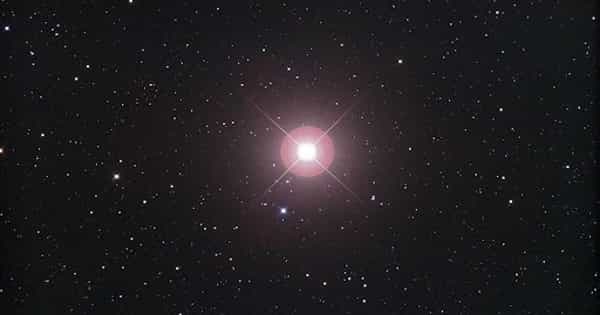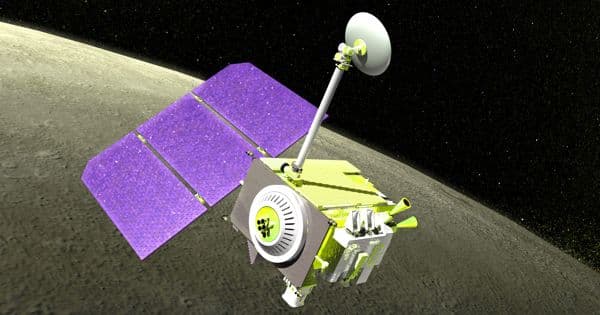Astronomers have discovered indications of a “hot spot” surrounding Sagittarius A*, the black hole at the center of our galaxy, using the Atacama Large Millimeter/submillimeter Array (ALMA). The discovery aids in astronomers’ understanding of the mysterious and dynamic surroundings of our supermassive black hole.
“We think we’re looking at a hot bubble of gas zipping around Sagittarius A* on an orbit similar in size to that of the planet Mercury, but making a full loop in just around 70 minutes. This requires a mind blowing velocity of about 30% of the speed of light,” says Maciek Wielgus of the Max Planck Institute for Radio Astronomy in Bonn, Germany, who led the study published today in Astronomy & Astrophysics.
The observations were carried out with the Event Horizon Telescope (EHT) Collaboration’s attempt to picture black holes using the ALMA radio telescope in the Chilean Andes, which is co-owned by the European Southern Observatory (ESO). The EHT, which connected eight active radio telescopes around the world, including ALMA, in April 2017, produced the just released first-ever image of Sagittarius A*.
Members of the EHT Collaboration Wielgus and his team used ALMA data collected concurrently with the EHT observations of Sagittarius A* to calibrate the EHT data. Unexpectedly, the scientists found more hints about the black hole’s characteristics in the ALMA-only readings.
By happenstance, some of the observations were carried out soon after an X-ray flare or burst from the galaxy’s center was observed by NASA’s Chandra Space Telescope. These flares, which have been seen before with X-ray and infrared observatories, are thought to be connected to “hot spots,” heated gas bubbles that orbit the black hole quickly.
“What is really new and interesting is that such flares were so far only clearly present in X-ray and infrared observations of Sagittarius A*. Here, we see for the first time a very strong indication that orbiting hot spots are also present in radio observations,” says Wielgus, who is also affiliated with the Nicolaus Copernicus Astronomical Center, Poland and the Black Hole Initiative at Harvard University, U.S..
In the future we should be able to track hot spots across frequencies using coordinated multiwavelength observations with both GRAVITY and ALMA the success of such an endeavor would be a true milestone for our understanding of the physics of flares in the Galactic center.
Ivan Marti-Vidal
“Perhaps these hot spots detected at infrared wavelengths are a manifestation of the same physical phenomenon: as infrared-emitting hot spots cool down, they become visible at longer wavelengths, like the ones observed by ALMA and the EHT,” adds Jesse Vos, a Ph.D. student at Radboud University, the Netherlands, who was also involved in this study.
The flares were long thought to originate from magnetic interactions in the very hot gas orbiting very close to Sagittarius A*, and the new findings support this idea.
“Now we find strong evidence for a magnetic origin of these flares and our observations give us a clue about the geometry of the process. The new data are extremely helpful for building a theoretical interpretation of these events,” says co-author Monika Mościbrodzka from Radboud University.
ALMA allows astronomers to study polarized radio emission from Sagittarius A*, which can be used to unveil the black hole’s magnetic field. The team used these observations together with theoretical models to learn more about the formation of the hot spot and the environment it is embedded in, including the magnetic field around Sagittarius A*.
Their research provides stronger constraints on the shape of this magnetic field than previous observations, helping astronomers uncover the nature of our black hole and its surroundings.
The observations confirm some of the previous discoveries made by the GRAVITY instrument at ESO’s Very Large Telescope (VLT), which observes in the infrared. The data from GRAVITY and ALMA both suggest the flare originates in a clump of gas swirling around the black hole at about 30% of the speed of light in a clockwise direction in the sky, with the orbit of the hot spot being nearly face-on.
“In the future we should be able to track hot spots across frequencies using coordinated multiwavelength observations with both GRAVITY and ALMA the success of such an endeavor would be a true milestone for our understanding of the physics of flares in the Galactic center,” says Ivan Marti-Vidal of the University of València in Spain, co-author of the study.
In order to go closer to the black hole and understand more about it, the team is also aiming to be able to directly see the orbiting gas clumps with the EHT. “Hopefully, one day, we will be comfortable saying that we ‘know’ what is going on in Sagittarius A*,” Wielgus concludes.
This research was presented in the paper “Orbital motion near Sagittarius A* Constraints from polarimetric ALMA observations” to appear in Astronomy & Astrophysics.
















